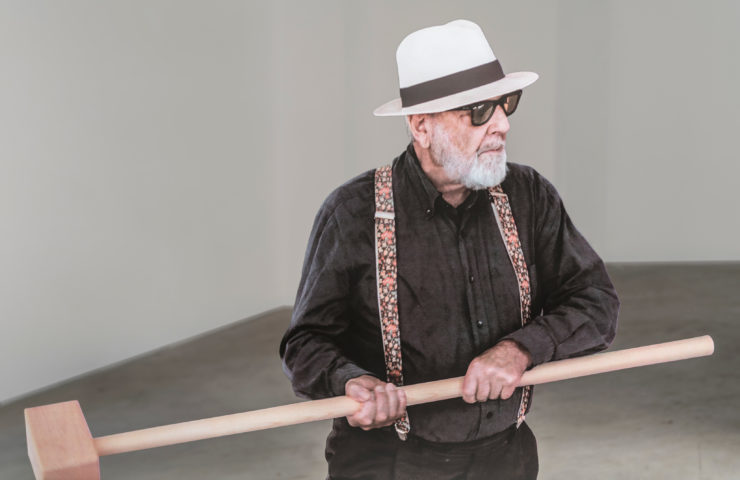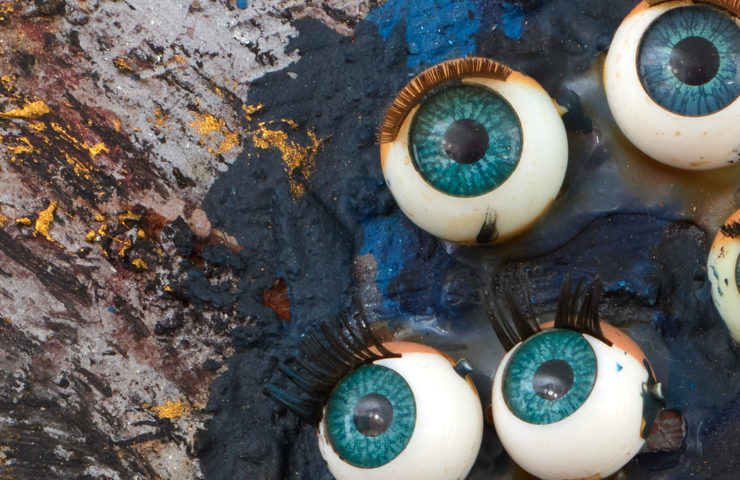Carol Rama
Bricolage, 1963
Oil, glass dolls’ eyes, gilded paint, copper wire, and glue on Masonite with artist’s frame
18 11/16 x 14 3/8 inches (47.5 x 36.5 cm)
© Archivio Carol Rama, Torino
Photo: Elisabeth Bernstein
I paint by instinct and I paint out of passion
And anger and violence and sadness
And a certain fetishism
And out of joy and melancholy together
And out of anger especially.
—Carol Rama
By the 1960s, Carol Rama had cultivated her avant-garde artistic practice for more than two decades in Turin. After her first solo exhibition was censored by Italy’s fascist government in 1945 on the grounds of the explicit nature of her watercolors—which depicted human figures in states of sexual ecstasy and featured motifs of institutionalized mental clinics—she briefly joined the Concrete Art Movement, embracing their central tenet of abstraction. Later in the 1960s, she would go on to fashion what she has come to be best known for, the Bricolage series. Drawn from the real world, the objects she incorporated into her paintings were eclectic, sourced from both nature (such as hair, fur, animal claws, and teeth) and industry (such as electrical fuses, plastic tubes, syringes, and batteries). In 1962, Rama’s close friend, the concrete poet Edoardo Sanguineti, gave the name Bricolage to the series of paintings to which the present work belongs—a title which she soon adopted as her own. Each Bricolage operates like one of Sanguineti’s disjunctive poems, carefully gathering and arranging materials to achieve an uncanny somatic charge.
The present work combines the most iconic compositional and technical devices in Rama’s arsenal. It features biomorphic painted forms, clusters of spiraling copper wire, as well as glass eyeballs manufactured for doll making. The dolls’ eyes—simultaneously striking in their artificiality and signaling consciousness—resonate with voyeuristic and fetishistic possibilities, implicating the viewer as both a purveyor and an object of their gaze. The two constellations of eyes are embedded in the explosive imagery of a mushroom cloud—a symbol of the potentially unbound destruction that has threatened human existence since 1945. Splatters of gold paint burst forth like light rays from imagery that is suggestive of male genitalia, alluding to the moment of la petite mort (“little death,” the term for an orgasm favored by the Surrealists, among others.)
Recent museum exhibitions of Rama’s work include The Passion According to Carol Rama, which traveled to the Museu d’Art Contemporani de Barcelona; the Musée de la Ville de Paris; the Espoo Museum of Modern Art, Finland; the Irish Museum of Modern Art, Dublin; and the Galleria Civica d’Arte Moderna e Contemporanea, Turin; as well as “Antibodies” at the New Museum, New York. Last year, Lévy Gorvy presented Carol Rama: Eye of Eyes in New York.
-

Andy Warhol
Ladies and Gentlemen (Wilhelmina Ross), 1975
-

Eduardo Chillida
Gure aitaren etxea, 1984
-

Carol Rama
Presagi di Birnam (Omens of Birnam), 1994
-

Mario Schifano
Untitled, 1975
-

Michelangelo Pistoletto
Rottura dello specchio–azione 2, 2017
-

Lygia Clark
Bicho em Si – Pq, 1966
-

Frank Stella
Untitled, 1969
-

Enrico Castellani
Superficie argento, 2006
-

Jana Euler
Dirty Gossip Rain, 2013
-

Carol Rama
Bricolage, 1963
-

Mickelane Thomas
Sugar Baby, 2004




